Glossary Content:
Anti de-Sitter space
Axion
Baryon
Big Bang
Big crunch
Black hole
Blackbody radiation
Boson
Brane inflation
Bubble nucleation
Bubbles, filaments, voids and sheets
Calabi-Yau Manifold
Cepheid
CERN
Chaotic inflation
Classical physics
Colour
Comoving horizon
Condensed matter system
Cosmic Microwave Background
Cosmic strings
Cosmological constant
Cosmological principle
Cosmology
COSMOS
Critical density
Dark Energy
Dark Matter
Deep field survey
Degrees of freedom
Dipole
Domain walls
Doppler-shift
Einstein, Albert
Electron
Electronvolt
Epoch
Escape velocity
Eternal inflation
Euclidean Geometry
Event horizon
Exotic particles
Fermilab
Fermion
Ferromagnet
Feynman, Richard
Fundamental forces
Fundamental Theory
Galaxy
Galaxy cluster
Galaxy survey
Gauge group
General Relativity
Gluon
Grand unification
Grand unification theory
Gravitational waves
Graviton
Hawking radiation
Heisenberg uncertainty principle
Holographic principle
Hubble, Edwin
Hubble's law and constant
Inflation
Inflaton
Instanton
Intercommuting and loop production
Interferometer
Kaluza-Klein Theory
Kelvin
Kibble Mechanism
Laws of thermodynamics
Light year
Local minimum
Luminosity
M-Theory
Matter era
Monopole
Nebula
Nematic liquid crystal
Neutron star
No-boundary proposal
Nucleon
Orbifold
Particle cosmology
Path integral
Phase transition
Photon
Planck area
Planck constant
Planck Epoch
Planck length
Potential energy
Quantum Chromodynamics
Quantum cosmology
Quantum Field Theory
Quantum gravity
Quark-Hadron transition
Quintessence
Radiation era
Recombination
Redshift
Scalar fields
Singularity
Spacetime
Special relativity
Speed of light
Spin
Standard cosmology
Statistical mechanics
String Theory
Strong and Electroweak forces
Supercluster
Supergravity
Supernova
Superstring Theory
Supersymmetry
Surface of last scattering
Symmetry breaking
Textures
The Great Attractor
Theory of Everything
Topological defects
Vacuum Manifold
World Line
Yang-Mills Theory
Anti de-Sitter space
When dealing with geometries that take place within the Universe, we deal not with conventional three-dimensional euclidean geometry, we have to adapt it to represent a four-dimensional spacetime. This results in what is known as a Lorentzian manifold. Within this geometry, we deal with three types of space, de-Sitter space, anti de-Sitter space and Minkowski space. They are analogues of spherical, hyperbolic and euclidean space with regards to four-dimensional spacetime.
Axion
This is a type of hypothetical particle of zero electrical charge that has come out of the framework of Quantum Chromodynamics. It is hypothesised that these were created during the very early Universe. They have little mass and do not easily interact with normal matter. No experimental evidence for them exists as of yet, but they are one of the possible contenders for dark matter.
Baryon
A baryon is a category of subatomic particle which is composed of three quarks. This is opposed to a meson, which is composed of one quark and one antiquark. Baryons include protons and neutrons and make up the majority of the mass of visible matter in the Universe (i.e. the mass of the Universe that is not Dark Matter or Dark Energy). They participate in the Strong Nuclear force.
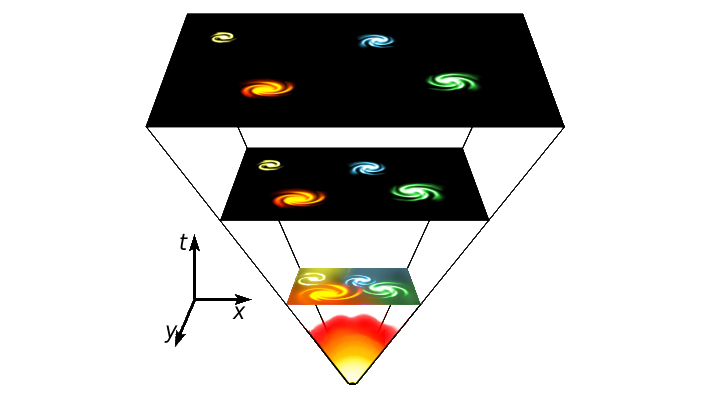
By projecting galaxy trajectories backwards (i.e. by reversing the time axis in the above diagram), we can show that the Universe began in an incredibly high-density state (Gnixon)
Big Bang
About thirteen billion years ago, the Universe began in a gigantic explosion. Every particle started rushing apart from every other particle in an early super-dense phase. The fact that galaxies are receding from us in all directions is a consequence of this initial explosion. Projecting galaxy trajectories backwards in time means that they converge to a high-density state.
Big Crunch
This is one of the possible ends to the Universe as we know it. Cosmic inflation is expands the Universe and gravitation brings matter together. Depending on the density of the Universe, one of these forces may overcome the other, or alternatively the Universe may be of critical density, which would result in a "flat" Universe. If the Universe has a density higher than this critical density, then gravitation will eventually overcome the forces working to expand the Universe, and the matter in the Universe would start to converge on other matter, until all the matter in the Universe converges into a singularity.
Given that we now know that the expansion of the Universe is accelerating, it now seems unlikely that this situation will arise.
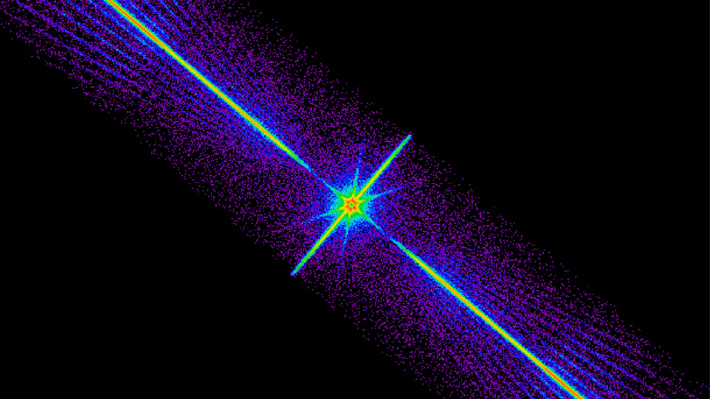
Chandra X-Ray Observatory image of a spectrum of a black hole. The lines coming out of the centre of the image are x-rays emitting from the black hole, sorted according to energy, those with highest energy are brighter and closer to the centre of the spectrum (NASA Cfa/J. McClintock et al)
Black hole
A black hole is a region of spacetime from which nothing can escape, even light.
To see why this happens, imagine throwing a tennis ball into the air. The harder you throw the tennis ball, the faster it is travelling when it leaves your hand and the higher the ball will go before turning back. If you were able to throw it hard enough, it would never return; the gravitational attraction will not be able to pull it back down. The velocity the ball must have to escape is known as the escape velocity.
As a body is crushed into a smaller and smaller volume, the gravitational attraction it exerts increases, and the escape velocity required to overcome this gets bigger. Things have to be thrown harder and harder to escape. Eventually, a point is reached when even light, which travels at 186 thousand miles a second, is not travelling fast enough to escape. At this point, nothing can get out as nothing can travel faster than light. This is a black hole.
Black hole formation starts when a large star has burnt all its fuel, exploding into a supernova. What remains after the supernova collapses down into a neutron star, which is extremely dense. If the neutron star is too large, its gravity overwhelms its internal pressure and the star collapses to form a black hole.
Blackbody radiation
A blackbody is a theoretical construct that absorbs all radiation that strikes it. No known material absorbs all radiation - some is always reflected off of it. Such a body would therefore appear completely black to all types of radiation spectrography.
Blackbody radiation is radiation emitted from the said theoretical construct, a perfect emission of radiation with 100% efficiency. At a certain temperature, for example, the blackbody would radiate the maximum amount of energy for that temperature. It must emit this radiation across all possible wavelengths and frequencies and is must also absorb all possible wavelengths and frequencies, which means that it can emit radiation at infinite wavelength.
Boson
Named after Indian physicist Satyendra Nath Bose, these are particles with full integer spin, i.e. 1, 2, 3. (as opposed to fermions, which possess half integer spin). There are two categories of fundamental boson (bosons not composed of a combination of other particles); gauge bosons, which mediate the fundamental forces of nature; and scalar bosons, which are constituents of a scalar field, and include the elusive Higgs boson. Bosons can also be created from other particles whose spin totals an integer, for example, any meson.
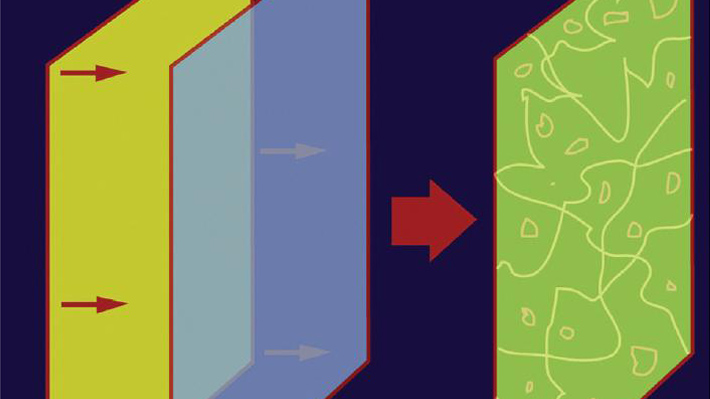
Brane inflation is one explanation as to the cause of the inflationary period in the Universe
Brane inflation
Brane inflation uses fundamental object of string theory, called branes. In this theory, the Universe is a three dimensional slide (a brane) in a high dimensional space (the bulk), which may also contain other branes. These slices of spacetime have mass and can attract each other by gravity, so two almost parallel branes separated by some distance will start moving towards each other. In brane inflation, the closer the two branes get to each other, the more the branes expand, giving rise to inflation.
The process ends with the violent collision of the branes, leading to the copious production of radiation and relativistic particles. Hence, the new brane resulting from the collision is filled with a hot plasma, which is the starting point of the standard Big Bang model. There is another prediction in the model: the collision is also accompanied by the production of cosmic strings.
Bubbles, filaments, voids and sheets
These are all types of large-scale structure formed from galactic distribution in the Universe. Galaxies form clusters and superclusters which arrange into sheets and filaments through the Universe. Between these sheets of galaxies, there is very low galaxy density, which leads to voids. These fill approximately 90% of space.

First order phase transitions proceed by bubble nucleation. A bubble of the new phase (the true vacuum) forms and then expands until the old phase (the false vacuum) disappears. A useful analogue is boiling water in which bubbles of steam form and expand as they rise to the surface
Bubble nucleation
Bubble nucleation is a form of first-order phase transition. A phase transition occurs when temperatures and densities increase such that matter changes its form and properties, such as in the very early Universe, during the Big Bang. A simple analogy is water, which melts from ice to liquid, and then boils to gas as temperatures increase. For physicists, it is important to note that as the temperature increases, the symmetry of the matter increases. Thinking this through, we know that gas is more symmetry than water, which in turn is more symmetric than ice. It is through this phase transitioning from higher to lower temperatures that we obtain the matter particles with which we are familiar today, i.e. protons, neutrons, photons etc..
First-order phase transitioning, or bubble nucleation, occurs through the formation of bubbles of the new phase in the middle of the old phase. These bubbles then expand and collider until the old phase disappears completely and the phase transition is complete.
Calabi-Yau Manifold
A manifold is a generalisation of a surface or space of N dimensions, which allows physicists to analyse that surface or space without reference to N+1 dimensions. When you look at any point on a manifold, the local area resembles traditional Euclidean space with N dimensions. Imagine you are sitting next to a piece of paper with pencil in hand. If you draw across the paper, you have draw a line, which itself is one dimensional, but sitting within the two dimensional plane in which you have drawn it (the X and Y axis). This line you have drawn can be represented by a manifold, which means that to analyse it you do not have to reference the two dimensional plane in which it is drawn. When dealing with cosmology, the kinds of manifold which are dealt with are much more complicated.
Calabi-Yau Manifold are very specific types of manifolds. Within string theory, it is predicted that the extra dimensions than we currently experience, with a total of 10 dimensions predicted (M-Theory predicts a total of 11). It is hypothesised that these extra six dimension could take the form of a Calabi-Yau Manifold, which would be so small that we cannot yet observe it.
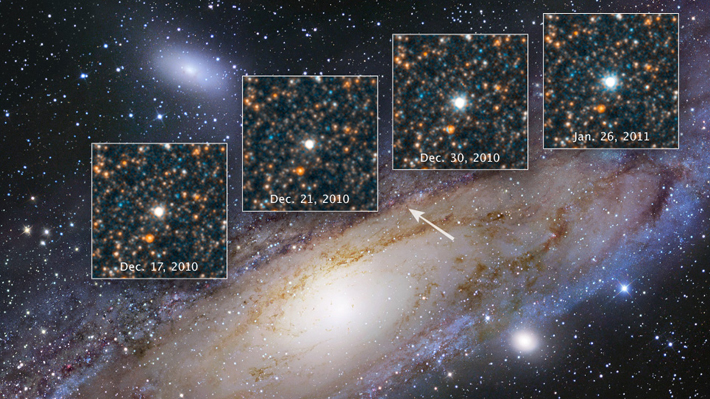
The luminosity of cepheids change over time, as demonstrated by cepheid V1, located in the Andromeda Galaxy, which was the first cepheid located by Edwin Hubble (NASA, ESA and STScI/AURA)
Cepheid
A cepheid is a type of variable star, that is, a star whose luminosity changes over time. They are formed when normal stars get very old, and swell to become red giants. These red giants eventually change and start to pulsate as they die. These are cepheids. They are very large, luminous and yellow, and they expand and contract, growing and fading in luminosity in periods typically on the order of 1 to 70 days.
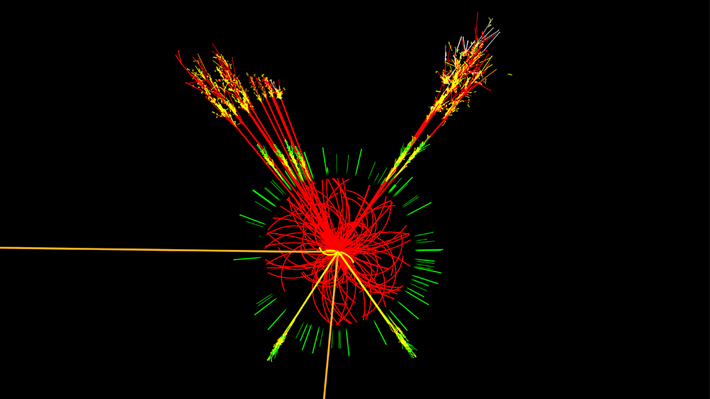
A diagram showing a potential "Higgs event" - a particle collision that leads to a release of energy that causes the creation of a Higgs boson - within ATLAS, one of the experiments that makes up the Large Hadron Collider (ATLAS Experiment © 2012 CERN)
CERN
The European Organization for Nuclear Research, headquartered in Geneva, was established in 1954 and is a research body dedicated to high-energy physics. It counts over 2,000 people as amongst its permanent staff and at any one time has thousands of visiting scientists and scientists with whom it works in collaboration. CERN's Geneva headquarters are also the location of the Large Hadron Collider - the world's largest particle accelerator. CERN's discoveries are too numerous to list here, but some of them include the first creation of antihydrogen, the discovery of W and Z bosons, the direct discovery of CP violation and, potentially, the discovery of the Higgs boson (currently there has been a discovery of a boson with a mass of ≈125 GeV/c2 to a 4.9 sigma significance that may be the Higgs boson).
Chaotic Inflation
Similar to eternal inflation, this theory holds that what we consider to be our Universe is only part of an infinite multiverse. Within this multiverse, there are different areas of space undergoing expansion. Our Universe is one of these areas of space. In eternal inflation, these inflationary areas can decay to lower-energy phases and cease to undergo inflation. This is in contrast to chaotic inflation, which sees inflationary areas undergo positive feedback, inflating forever.
Classical Physics
This refers to physics which does not take into account quantum physics. In different contexts, it can apply to different theories. Classical Newtonian physics, which treats quanta as waves or particles is considered classical physics. Within the world of quantum mechanics, the theories of general and special relativity can also be consider classical on the basis that they do not specifically form part of the quantum paradigm.
Colour
Unrelated to any visual representation of colour, such as we witness in rainbows and the like, colour is a type of charge associated with the Strong Nuclear force, one of the fundamental forces, in quarks and gluons. It is similar to, but not the same as the electrical charge that particles may exhibit. There are three values of colour, these are Blue, Green and Red. Colour is a degree of freedom that allows quarks to exist together to form hadrons, such as protons or neutrons, in otherwise identical quantum states. This is necessary as otherwise they would be in violation of the Pauli exclusion principle, which states that no two identical fermions may occupy identical quantum states simultaneously.
Comoving horizon
Comoving distance is the distance between two objects as it appears if the expansion of the Universe is factored out. At any given time, it is equal to the proper distance, which is the actual distance between two objects, and will change over time due to the expansion of the Universe. The comoving horizon is therefore the actual distance to the edge of what we can see at any given time.
Condensed matter systems
Condensed matter systems deal with, as the name suggests, condensed matter. This includes matter in the liquid, solid, superconducting phases. Condensed matter systems can be used to study the effects of phase transitions on matter.
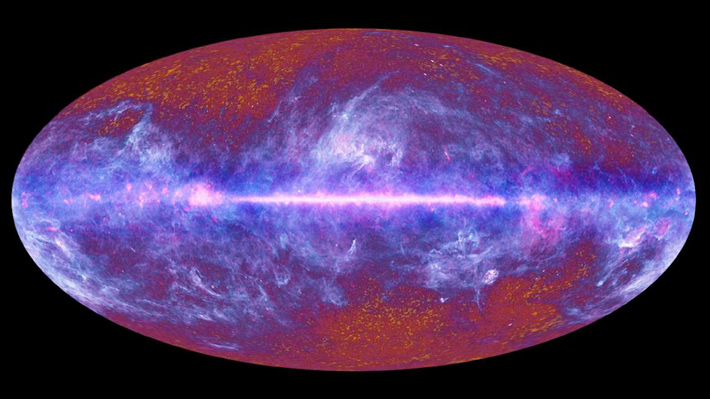
The ESA's Planck Satellite provides us with the best data so far on the Cosmic Microwave Background
Cosmic Microwave Background
Around 370,000 years after the Big Bang, the temperature of the Universe dropped sufficiently for electrons and protons to combine into hydrogen atoms: p + e = H . From this time onwards, radiation was effectively unable to interact with the background gas, so it has propagated freely ever since, while constantly losing energy as its wavelength is being stretched by the expansion of the Universe. Originally, the radiation temperature was about 3000 degrees Kelvin (i.e. approximately 3300 degrees Celsius, 5000 degrees Fahrenheit), whereas today it has fallen to only 3K.
Observers detecting this radiation today are able to see the Universe at a very early stage. Photons in the CMB have been travelling towards us for over ten billion years, and have covered a distance of about a million, billion, billion miles. The CMB was discovered in 1964.
Cosmic Strings
These are one-dimensional (that is, line-like) objects which form when an axial or cylindrical symmetry is broken. Strings can be associated with grand unified particle physics models, or they can form at the electroweak scale.
They are very thin and may stretch across the visible Universe. A typical GUT (Grand Unified Theory) string has a thickness that is less then a trillion times smaller that the radius of an hydrogen atom. Still, a 10 km length of one such string will weigh as much as the Earth itself!
Cosmological constant, Λ
Originally proposed by Einstein as a modification to General Relativity to result in a Universe which would neither expand nor contract. He later famously called it his greatest mistake after Hubble discovered that other galaxies were moving away from us using redshift. Different values of the constant can be used to explain different scenarios in which the Universe might contract or expand. Given that we now know that the expansion of the Universe is accelerating, physicists are now looking to the cosmological constant as a possible explanation. Specifically, the cosmological constant may be related to the dark energy that pervades our Universe, working against gravity to expand the Universe.
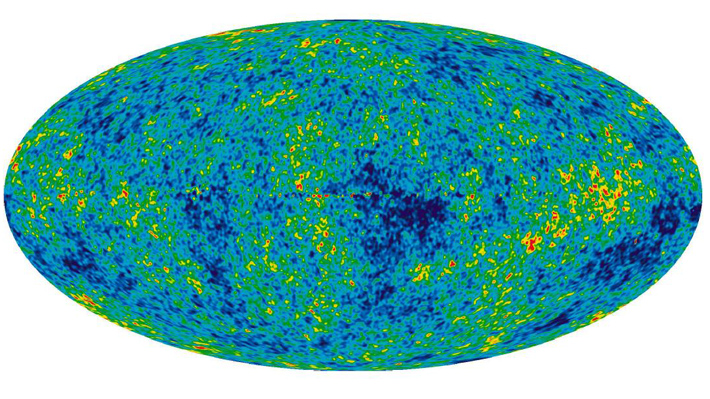
The cosmological principle states that no position in the Universe is in any sense preferred over another. Evidence collected on the Cosmic Microwave Background by the WMAP satellite supports this view (NASA)
Cosmological principle
This states that the Universe appears the same in every direction from every point in space. It asserts that our position in the Universe - on the very largest scales - is in no sense preferred. There is considerable observational evidence for this assertion, including the measured distributions of galaxies and faint radio sources, though the best evidence comes from the near-perfect uniformity of the cosmic microwave background radiation. This means that any observer anywhere in the Universe will enjoy much the same view as we do, including the observation that galaxies are moving away from them. It should be noted that this does not mean local structures will be different, i.e. local stars etc. will be different for different observers, but more that the physical laws which govern these observable phenomena will be the same and background effects across the Universe will be equal.
Cosmology
Cosmology is the study of the large scale Universe, its origins, evolution, laws and its eventual fate. Whereas astronomy is concerned with objects within the Universe, cosmologists are more concerned by the Universe as a whole.
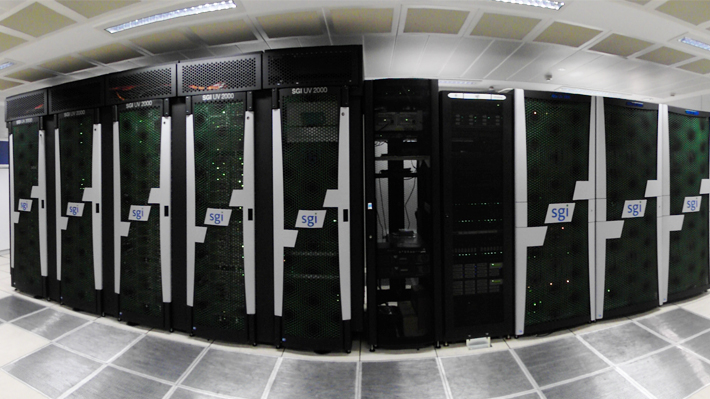
COSMOS, the UK's national cosmology supercomputer, hosted by the University of Cambridge (Andy Barrington)
COSMOS
The UK's national cosmology supercomputer. It is housed within the Department of Applied Mathematics and Theoretical Physics, here in Cambridge. Having recently undergone its ninth iteration, it is the most powerful shared memory system in Europe. It is available for use for both academic and non-academic users, and is part of the STFC's high-performance computing DiRAC facility.
Critical density
This reference to the density of our Universe. Matter density in the Universe plays a critical role towards understanding what will happen to the Universe in the future, specifically, whether it will continue expanding until perhaps the Universe grows so cold that life is unsustainable, or that matter is literally ripped apart, or whether gravitation will eventually overcome expansionary forces and the Universe will collapse in some Big Crunch. A Universe with less than critical density will continue expanding at a forever accelerating rate, whereas a supercritical Universe will invariably collapse.
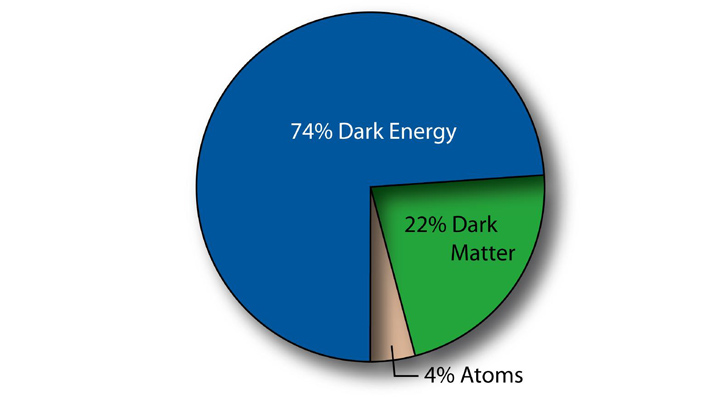
Only 4% of the mass of our Universe is made up of ordinary matter
Dark Energy
In the late 1990s, it was discovered that the expansion of the Universe is accelerating. It is expected that due to gravity’s influence, bringing matter together, would slow down the acceleration of the expansion of the Universe. Therefore either whatever is responsible for this acceleration is not normal matter, or gravity must get weaker on large scales. This unknown physical phenomenon responsible for this acceleration is known as dark energy. To completely explain the acceleration then there isn’t only a little dark energy in the Universe, there’s a lot of it. In fact, it must make up 74% of the mass of the Universe. Dark matter must make up 22% of the Universe, with only 4% of the Universe being the matter that is currently known to us.
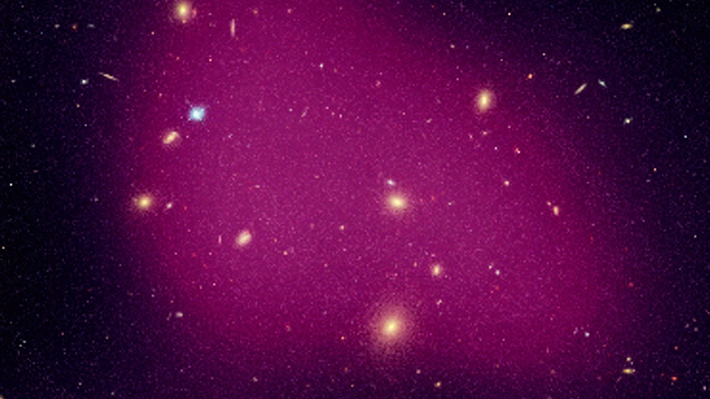
Dark Matter distribution (purple) shown within a galaxy supercluster. The galaxies lie in the clumps of dark matter (NASA/ESA/STAGES/COMBO-17)
Dark Matter
There is strong evidence that the Universe consists primarily of dark (non-luminous) matter, also that this matter is of an exotic, non-baryonic form. Baryons are made up of three Quarks, a type of elementary particle. Baryons include protons and neutrons.
Deep field survey
A deep field survey is a galaxy survey which looks deeper into the sky than the average galaxy survey. Because electromagnetic waves have a speed limit (the speed of light), the further away from us that we look, the further back in time we are looking, as the waves that are currently reaching us will have been radiated billions of years ago. Hubble Ultra-Deep Field, the deepest image of the Universe that we currently have, shows us a time period corresponding to roughly 400-800 million years after the Big Bang.
Degrees of freedom
A degree of freedom, in physics (as opposed to mathematics, which can have different meanings), is a parameter that can help define the state of an object to differentiate it from others. A simple example would be charge amongst particles. Some particles are charged, some are not, and as a result they behave differently. At a quantum level this becomes important because certain particles with the same values for their varying degrees of freedom (i.e. spin, charge etc.) cannot exist in the same place at the same time.
Dipole
An object which generates a magnetic field emanates that field from two opposite poles, an example of this would be a bar magnet, which has a north and south pole. Each of these poles is a magnetic monopole. The magnet itself, having two of these poles, is a dipole. This is similar to an electric field, in which the field emanates from positive and negative charges. Whereas in electricity, negative and positive charges can be easily isolated in the form of electrons and positrons, magnetic monopole particles have yet to be discovered. For example, when you break up a bar magnet, you do not isolate the two monopoles, you simply have two bar magnets half the size of the previous one.
Domain Walls
These are two-dimensional objects that form when a discrete symmetry is broken at a phase transition. A network of domain walls effectively partitions the Universe into various 'cells'. Domain walls have some rather peculiar properties. For example, the gravitational field of a domain wall is repulsive rather than attractive.
Doppler-shift
When the source of a wave moves away from us, we observe a change of frequency of that wave. An example would be an ambulance or fire-truck - we hear a lower pitch in its siren once it has passed us by. This is the Doppler-shift. It is not, however, limited to sound waves, but any kind of waves, including electromagnetic.
Einstein, Albert
(b. 1879 d. 1955), was a German theoretical physicist who spent much of his career at the Kaiser Wilhelm Institute for Physics and Princeton University. He is regarded as one of the greatest physicists of the 20th century, and indeed, one of the most academically brilliant minds of all time. Awarded the Nobel Prize in Physics in 1921, for his work on the photoelectric effect where he described photons as discrete packets, known as quanta. This was in direct conflict with previous, classical descriptions of physics which defined photons as wave. His theories are now the basis of modern physics. These theories, whilst too numerous to list here, include special relativity, which describes how relative motion can result in different laws of physics being experienced by different observers as well as the energy-mass equivalence relationship, E=mc2, and general relativity, which generalises special relativity with respect to gravity and incorporates this with Newtonian laws of gravity to describe a how gravity is a geometry property of spacetime. When Hitler came to power in 1933, he was on a trip to America and did not return to German, instead opting to become an American citizen. His warning to President Roosevelt about the German research into nuclear weapons led to the eventual development of the atomic bomb, a weapon he later denounced and crusaded against. Such was Einstein's genius that upon his death his brain was removed for future study.

Electrons being manipulated by magnetic fields. Their circular motion releases cyclotron radiation, the light you can see (Marcin Białek)
Electron
An elementary particle carrying a negative elementary electric charge (that is, the most fundamental electric charge, particles do not carry charge smaller than this). A fermion with spin 1/2. It is a lepton and therefore is a constituent of matter, but does not participate in the Strong Nuclear force. It does interact with Electromagnetism, Gravitation and the Weak Nuclear force.
Electronvolt
Energy unit equal to approximately 1.6 x 10-19 Joules. It is the amount of energy gained by the charge of one electron as it moves across a one volt electric potential difference.
Epoch
A period in time. In cosmology it is used to refer to different time periods in the chronology of the Universe. These include the Planck epoch; the Grand Unification epoch; the Electroweak epoch; the Quark epoch; the Hadron epoch; the Lepton epoch; and the Photon epoch (all of the epochs prior to the Photon epoch occurred within the first 10 seconds of time!). Time periods after this include Nucleosynthesis, Recombination and Reionization.
Escape velocity
This is the speed required for any object to break free of another objects gravitational field. For the Earth, this is approximately 7,000 miles per second. Mathematically, it is described as the velocity at which the escaping object's kinetic energy and gravitational potential energy summate to zero. As the gravitational force exerted by an object on another object increases as the distance between the two decreases, the further away the escaping object is, the lower the escape velocity. For black holes, at the distance known as the event horizon, the escape velocity is greater than the speed of light, and therefore nothing can escape.
Eternal inflation
Eternal inflation refers to a series of models by which at least one region of the Universe is undergoing inflation at any one point in time. Due to the exponential increase in volume during these periods of inflation, it is theorised that at any given point the majority of the volume of the Universe is still expanding. This creates a multiverse, whereby each expanding area of the Universe appears, to be its own Universe, and the beginning period of expansion equivalent to the Big Bang. In eternal inflation it is possible for these expanding areas of space to decay into a lower energy phase, resulting in inflation ceasing.
Euclidean geometry
Named after Euclid, a Greek mathematician of the third century BC. It is a system of geometry based around the geometry of the three dimensions that we are all taught at school; x, y and z. Points within the system can be described by a set of Cartesian coordinates. It is described by a system of postulates, or premises, for example, the parallel postulate, which states that "if a straight line falling on two straight lines makes the interior angles on the same side less than two right angles, the two straight lines, if produced indefinitely, meet on that side on which are the angles less than the two right angles".
In contrast to this is non-Euclidean geometry, which deals with curved space.
Event horizon
The event horizon is the boundary that marks the point where the escape velocity of a black hole exceeds the speed of light. Once the event horizon has been crossed, nothing can escape from the black hole’s gravitational pull, not even light.
Exotic particles
Exotic particles are those made up of theorised particles not currently part of the standard model. An example of this would be the heavier partners of the current set of particles that make up the standard model, that are described within the theory of supersymmetry.

Fermilab, located close to Chicago, Illinois (amccrim)
Fermilab
Full title: the Fermi National Accelerator Laboratory. Located near Chicago, IL., it is a United States Department of Energy laboratory focussed on high-energy physics. Until 2011, it house the Tevatron particle accelerator, which until the opening of the Large Hadron Collider at CERN, the largest in the world. In 1995 work done at the Tevatron led to the discovery of the Top Quark, one of the six different flavours of quark, and the most massive of them all.
Fermion
These are particles with half integer spin. This is opposed to bosons, which have full integer spin. Only one fermion can occupy the same quantum state and space at any given time, this is known as the Pauli exclusion principle, and does not apply to the other class of particles, bosons. Elementary fermions (those not composed of other particles) are constituents of visible matter in the Universe, and include electrons and quarks. Particles composed of fundamental fermions, however, can have full integer spin and therefore can be classed as bosons.
Ferromagnet
A ferromagnet is an object which exhibits the property of ferromagnetism. Ferromagnetism is the strongest type of magnetism, and as such ferromagnets are the magnets that the average reader will be familiar with. They are the ones used in physics classes at school, they are the ones used to pick up scrap metal, they are the magnets on your fridge. Ferromagnetism is the only type of magnetism that has the strength to produce a force that can be felt. A ferromagnet can be defined as a material that can exhibit a net magnetic moment in the absence of an external magnetic field.
Feynman, Richard
(b. 1918-d.1988), was a physicist who spent most of his life working at the California Institute of Technology (Caltech). Also worked on the Manhattan Project at Los Alamos National Laboratory, where he helped develop the atomic bomb. Won the Nobel Prize in Physics in 1965 for his work in Quantum Electrodynamics (QED). Developed the path integral formulation that we use today, and developed an illustrative representation scheme for the behaviour of subatomic particles which has become known as Feynman diagrams. Caltech has a named Chair of Physics in his honour.
Outside of his life in physics, he also was a member of the panel that investigated the Space Shuttle Challenge crash, and wrote two popular science books: "Surely you're joking, Mr. Feynman!" and "What do you care what other people think?".
Fundamental Forces
There are four fundamental forces in nature. They are Electromagnetism, the Weak Nuclear Force, the Strong Nuclear Force and Gravitation.
The Weak Nuclear Force is associated with radioactivity in unstable nuclei, specifically the decay of a neutron into a proton in the form of Beta radiation. The gauge bosons that mediate the force are the W and Z bosons. This interaction can cause quarks to change flavours.
The Strong Nuclear Force binds together quarks to form nucleons, in turn, it also acts to bind these nucleons together, forming atomic nuclei. The force is mediated by an exchange of gluons, which are a type of gauge boson. The charge associated with this force, analogous to the electric charge associated with electromagnetism, is the Colour charge, of which there are three varieties; Red, Green and Blue. The mathematical theory describing the elementary particles interacting with this force, Quarks and Gluons, is known as Quantum Chromodynamics (QCD). At atomic levels, it is by far the strongest of all forces, but only interacts on a scale on the order of 10-15m, and therefore, whilst incredibly important for the formation of matter, does not play any observable role in day to day life.
Electromagnetism is a force associated with the electric charge associated with certain molecules. Along with gravitation, is is one of the four forces that has a major noticeable effect on day to day human life. It manifests as two different fields electric fields and magnetic fields, although they are aspects of the same force and therefore interact with each other through electromagnetic induction. The gauge boson that mediates this force is the photon, which is also the quanta (discrete packet) of light and other forms of electromagnetic radiation, such as infra-red radiation (most thermal radiation), X-rays, Ultraviolet radiation etc..
Gravitation is a force of attraction between two massive bodies. Objects on Earth are attracted to the Earth via gravitation, why is why, when an apple falls from a tree, it falls down towards the Earth, instead of in any other direction. Gravitation also gives weight to objects, weight being the mass of an object multiplied by the gravitational force acted upon it by another object. Gravitation on a Universal scale is described by Einstein's theory of General Relativity, where it is described as being a result of curved spacetime. Classically, it has been described by Newton's law of gravitation, which is an accurate approximation up to a certain level of detail. Gravitation is mediated by the still-hypothetical gauge boson the Graviton. On a quantum level, there is no sufficient theory that can explain the force, although string and M-Theory are potential candidates. Explaining gravity on a quantum level is one of the major challenges in present-day physics.
Fundamental Theory
This refers to so called “theories of everything”, which try to link the four known fundamental forces; electromagnetism, the weak nuclear force, the strong nuclear force, and gravitation. Fundamental theory can be thought of as beyond the standard model. This label encompasses theories such as superstring theory and M-Theory.

Galaxy UGC 1810, a spiral galaxy. At the bottom of the picture is an arm of Galaxy UGC 1813, which is interacting with UGC 1810 (NASA/ESA/STScI/AURA)
Galaxy
A galaxy is a group of gravitationally bound stars, solar systems, stellar remnants (such as neutron stars), interstellar gas and dust, and mysterious dark matter. There are many different categories of galaxy, including spirals, ellipticals, irregulars and lenticulars. Our own galaxy, the Milky Way, consists of around 200 billion stars, although galaxies can have as few as ten million and as many as one hundred trillion.
Galaxies form large-scale structures within the Universe due to their gravitational attraction, these include groups, clusters, filaments, voids, bubbles and superclusters.
Galaxy cluster
These are groups of galaxies attracted together by gravity. Typically, they contain somewhere in the range of 1012 to 1015 solar masses (i.e. a thousand million to a million billion suns). Regular clusters normally have a concentrated central core and well-defined spherical structure, irregular clusters have no defined centre. Our Local Group consists of approximately 54 galaxies, including the nearby spiral galaxy, and largest member of the group, Andromeda.
Galaxy survey
This is a mapping/imaging of a section of the sky to measure redshifts of objects within that section. Comparing redshifts between different electromagnetic sources allows us to build up a three dimensional map of the sky, which allows us to gain insight into the large-scale structures within the Universe.
Gauge group
A gauge group is a set of gauge transformations which effect a system in similar manners. A gauge transformation is a transformation that acts on redundant degrees of freedom within a system, that is, it effects a property that does not really have any physical significance at the level at which the system operates.
A gauge transformation which is globally symmetric effects all points of space in the same way. An example of this would be a transformation of voltage that states that Voltage1 = Voltage2 + C (a constant). If we substitute the left hand side of the equation with the right in classical equations dealing with electromagnetism, there is no difference in the outcome and therefore this will hold across any difference in voltage.
If we impose a local symmetry on the gauge transformation, also known as gauge invariance, then these transformations become very significant. This is because the transformation holds true, but the transformation is now a function of the position in space and time.
Through introducing these conditions of gauge invariance into quantum equations, one can extrapolate that for particles that interact with fundamental forces, such as the electron, which carries electrical charge and is acted upon by electromagnetism, there is an underlying field which is also undergoing a gauge transformation. In the case of the electron, it is the electromagnetic field, which physicists were already aware of, however, gauge invariance has postulated the gluon field which is the basis for quantum chromodynamics, the theory which explains the strong nuclear force.
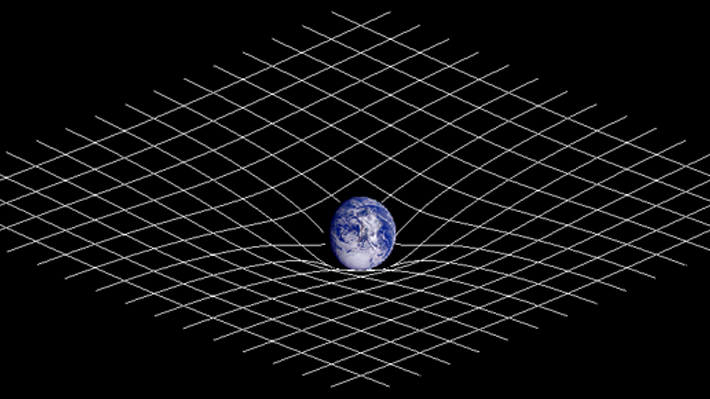
General relativity states that spacetime is a dynamic field (Johnstone)
General Relativity
This is the modern geometric description of gravity. It says that the gravitational force is related to the curvature of spacetime itself, i.e. to its geometry. To this end, it generalises Einstein's theory of special relativity, and links it to Newton's laws of gravity. Unlike for non-gravitational physics, spacetime is not just an arena in which physical processes take place, but it is a dynamical field. The gravitational field at a fixed time can be described by the geometry of the three spatial dimensions at that time.
Gluon
These are gauge bosons which mediate the Strong Nuclear force, one of the fundamental forces. Similar to the Photons which mediate the Electromagnetic force, gluons have no rest mass and so travel at the speed of light. Although unlike photons, which whilst mediating the electromagnetic force, are themselves electrically neutral, gluons have charge associated with the Strong Nuclear force, or Colour. There are 8 different colours of gluon. Gluons are confined within hadrons, particles made up of quarks (which have a colour charge), and are limited in interaction to a distance of approximately 10-15 metres.
Grand Unification
See Grand Unified Theory.
Grand Unified Theory
In the aftermath of the Big Bang, the Universe was extremely hot and extremely dense. At these energies, the laws of nature that we know were changed. The fundamental forces that we see in nature were unified - the Universe was in a state of Grand Unification - it is only as the Universe expanded and cooled that Gravitation, Electromagnetism and the Strong and Weak nuclear forces all ceased to be as one. Electroweak theory describes the unification of the Weak Nuclear force and Electromagnetism. A Grand Unified Theory will marry up Electroweak theory with the Strong Nuclear force, brining us closer to a unification of the four fundamental forces.
Gravitational waves
Gravitational waves are propagating disturbances in spacetime. The effect of a passing gravitational wave is to periodically stretch and compress space in the two directions perpendicular to the direction of propagation. The expected strain on the Earth due to these disturbances, which can be caused by black holes merging, is very small, making detection extremely difficult.
Graviton
This is an as yet undiscovered particle that is believed to mediate the force of gravitation. Much like the photon, which mediates the electromagnetic force and the gluon which mediates the Strong Nuclear force, it has no mass, and therefore travels at the speed of light. It has a spins quantum number of 2,and is the only massless particle with that spin number. It has zero electrical charge. Experimentally, the graviton is incredibly difficult to observe, and is beyond the reach of current physics. The detection of gravitational waves may lead to some further information about gravitons, but these have not yet been detected. Theories of quantum gravity are one of the largest standing issues in cosmology, and there are currently few mathematically consistent theories that can explain it. One of these theories is M-Theory, which we believe to be the best explanation at this point in time.
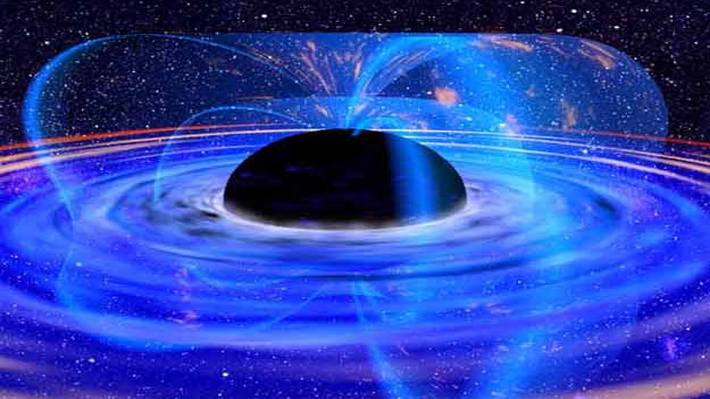
An illustration of a black hole surrounded by an accretion disk. The image does not take into account distorting gravitational lens effects (XMM-Newton/ESA/NASA)
Hawking Radiation
This is a type of blackbody radiation emitted by black holes. This radiation is a form of energy and because of the energy-mass equivalence relationship, E=mc2, the loss of energy through this radiation also leads to a loss of mass for the black hole. This not only means that black holes are not truly black (in the sense that they do have emissions), but it also means that should they not take in more mass than they radiate, they will eventually radiate away into nothing. This process is known as black hole evapouration.
Heisenberg uncertainty principle
The Heisenberg uncertainty principle states that the more precisely determined one of two properties, position and momentum, of a particle is, the less precisely determined is the other. This results from the wave-matter nature of particles and is independent of who is observing the momentum or position and so this principle can't be overridden by improvements in technology. This is in contrast to the similar observer effect, which states that in affecting the observation of a particle, say by bombarding an electron using gamma-rays, you are changing its momentum, and therefore the observer cannot obtain accurate knowledge of both at any one time.
The uncertainty principle is also in sharp contrast to classical wave mechanics, which says that precise simultaneous values can be assigned to different physical quantities.
Holographic principle
This is a principle which operates within certain string theories and theories of quantum gravity. It was proposed in 1993 by G. 't Hooft. It consists of two basic assertions:
Assertion 1 The first assertion of the Holographic Principle is that all of the information contained in some region of space can be represented as a 'Hologram' - a theory which 'lives' on the boundary of that region. For example, if the region of space in question is a room, then the holographic principle asserts that all of the physics which takes place in the room can be represented by a theory which is defined on the walls of the room.
Assertion 2 The second assertion of the Holographic Principle is that the theory on the boundary of the region of space in question should contain at most one degree of freedom per Planck area.
Within M-theory, the holographic principle suggests we are the shadows on the wall. The 'room' is some larger, five-dimensional spacetime and our four-dimensional world is just the boundary of this larger space. If we try to move away from the wall, we are moving into an extra dimension of space - a fifth dimension.
Hubble, Edwin
(b.1889-d.1953) was one of the main figures of astronomy in the 20th century. Using the Hooker 100 inch telescope at Mount Wilson Observatory in California, discovered the galaxies are receding away from us and from each other via the changes in frequency that they exhibit - the shifting of frequency of electromagnetic emissions to the red end of the spectrum. This realisation was crucial as evidence for an expanding Universe, which, if reversed, supports the notion of a Big Bang at the beginning of the Universe. Famously not awarded the Nobel Prize on the basis that at the time, research in astronomy was not eligible for the Nobel Prize in Physics.
Hubble's Law and Constant
Hubble's law states that all objects in deep space (i.e. galaxies) are receding away from us and each other (as can be seen by the fact that they are Doppler-shifted), and that the velocity of this recession is proportional to their distance away from the Earth and other astral bodies. It is summarised mathematically by the equation: v=H0D, where v is the recession velocity, H0 is the Hubble constant and D is the distance away from us that the body is. H0 has an approximate value of 70 kms-1Mpc-1 (kilometers per second, per megaparsec), but a there is disagreement over its precise value.
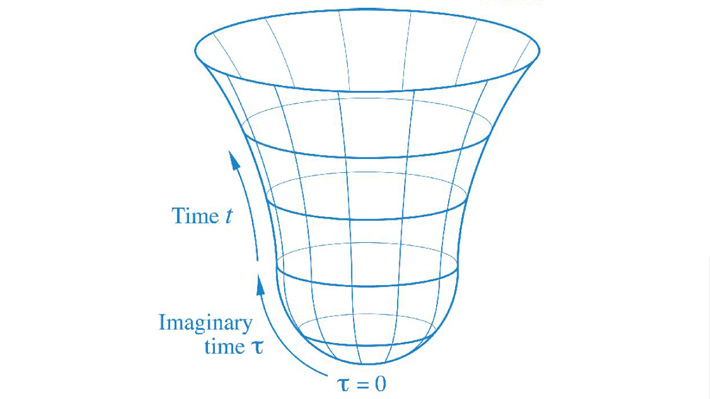
The Universe underwent a period of expansion immediately after the Big Bang that saw its volume expand by a factor of 1026
Inflation
According to the theory of inflation, the early Universe expanded exponentially fast for a fraction of a second after the Big Bang. A simple model for the expansion of the Universe is to consider the inflation of a balloon. A person at any point on the balloon might consider himself or herself to be at the centre of the expansion, as all neighbouring points are getting further away.
During inflation the Universe expanded by a factor of about e60=1026. This number is a one followed by 26 zeros. It transcends normal political/economic discussions of inflation.
Inflaton
This is a hypothetical particle and scalar field associated with the inflation of the Universe that occurred moments after the Big Bang. It is theorized that this occurred because of a phase transition which allowed the inflaton field to release potential energy as matter and radiation as it moved to a lower energy state. This energy acted as a repulsive force inflating the Universe.
Instanton
We calculate the probability that a system in state A will end up in state B by using path integrals. This mathematical framework uses contributions from all the probabilities of the paths that the system could take in order to end up in state B to give an answer.
So, when we are using path integrals to try and calculate what the very early Universe looks like, we look at the geometry, which, as we know from general relativity is related to gravity and therefore the distribution of matter, and we try to work back towards times when the Universe was at a quantum level. For mathematical reasons, we work not in three dimensions of space and one of time, but four dimensions of spacetime, or four dimensions of geometry.
Path integrals work well on large scale systems, but less well on a quantum level - an approximation has to be used. This is known as the semiclassical approximation, because its validity lies somewhere between that of classical and quantum physics.
In the semiclassical approximation one argues that most of the four dimensional geometries occuring in the path integral will give very small contributions to the path integral and hence these can be neglected. The path integral can be calculated by just considering a few geometries that give a particularly large contribution. These are known as instantons. Instantons don't exist for all choices of boundary three geometry; however those three geometries that do admit the existence of instantons are more probable than those that don't. Therefore attention is usually restricted to three geometries close to these.
Remember that the path integral is a sum over geometries with four spatial dimensions. Therefore an instanton has four spatial dimensions and a boundary that matches the three geometry, or the geometry of the Universe at a given time, whose probability we wish to compute. Typical instantons resemble (four dimensional) surfaces of spheres with the three geometry slicing the sphere in half. They can be used to calculate the quantum process of Universe creation, which cannot be described using classical general relativity. They only usually exist for small three geometries, corresponding to the creation of a small Universe. Note that the concept of time does not arise in this process. Universe creation is not something that takes place inside some bigger spacetime arena - the instanton describes the spontaneous appearance of a Universe from literally nothing. Once the Universe exists, quantum cosmology can be approximated by general relativity so time appears.
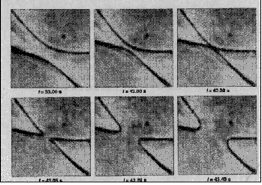
Long-string intercommuting in a liquid crystal. The two strings exchange ends at the crossing
Intercommuting & loop production
There are properties exhibited by cosmic strings. Intercommuting refers to a process whereby strings exchange ends whenever they meet. A loop is produced whenever a string intercommutes with itself. Although cosmic strings have not been detected, this process of intercommuting can be seen in certain liquid crystals.
Interferometer
An interferometer is a machine that uses a process of wave interference to learn about the waves in question. That is, the waves are superimposed upon themselves to discover their properties.
Kaluza-Klein Theory
Kaluza-Klein Theory is a theory that seeks to unify two of the four fundamental interactions; gravitation and electromagnetism. A similar theory, Electroweak Theory, already unifies the weak nuclear force and electromagnetism. Its proposals extend general relativity into five-dimensional spacetime.
Kelvin
The SI (or base) unit for temperature measurement. Kelvin and Celsius have the same magnitude scale, therefore you can transform one Kelvin into Celsius by adding 273.16 to the number. Whereas the Celsius scale was created by dividing the difference in temperature between water freezing and boiling by one hundred and labelling the freezing point of water as 0, 0 Kelvin is the point described by Lord Kelvin (after whom the unit is named) as "infinite cold", or absolute zero.
Kibble Mechanism
This is the mechanism by which cosmic topological defects form during a phase transition.
Causal effects in the early Universe can only propagate at the speed of light. This means that at a time t, regions of the Universe separated by more than a distance d=ct can know nothing about each other. In a symmetry breaking phase transition, different regions of the Universe will choose to fall into different minima in the set of possible states. Topological defects are precisely the 'boundaries' between these regions with different choices of minima, and their formation is therefore an inevitable consequence of the fact that different regions cannot agree on their choices.
Laws of thermodynamics
These are laws which define the fundamental physical properties which characterize) thermodynamic systems. These are temperature, energy and entropy (a property that works systems towards equilibrium). They are:
The zeroth law: If two systems are in thermal equilibrium with a third, they must be in thermal equilibrium with each other also.
The first law: Heat and work are forms of energy transfer. This is the law of the conservation of energy. Internal energy in a closed system may change if heat or work are transferred in or out of the system.
The second law: The entropy of any isolated system not in thermal equilibrium almost always increases. That is, an isolated system will work towards thermal equilibrium.
The third law: The entropy of a system approaches a constant value as the temperature approaches zero.
Light year
This is not, despite the name, a measure of time, but rather a measure of length. It is the length that light will travel in a vacuum in a year, that is 365.25 days. Its exact value is 9,460,730,472,580,800 metres, but is approximately given by 9.4607x1015m. This is calculated by multiplying the number of days (365.25) by the number of seconds in each day (86,400) and then multiplying that by the speed of light in a vacuum, which is 299,792,458 metres per second.
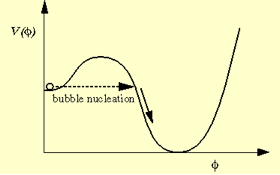
During a phase transition, the matter fields get move from a higher energy 'false vacuum' state to the lower energy 'true vacuum' state, in which they appear in a new phase. This new state is represented by the minimum
Local minimum
In a mathematical function, the highest and lowest values of that function, over the domain of said function, are defined as the maximum or minimum points respectively. A local minimum or maximum value is defined by taking the highest or lowest value in the function over only part of the domain. An example of a function with several local minimum and maximums would be a graph of sin(x), which has no overall maximum or minimum value, but several local maximums and minimums of equal respective values.
Luminosity
An object's (in our context, an astronomical object) brightness as measured by the flux, or intensity of electromagnetic radiation, that the object gives out.
Matter Era
During the radiation era, shortly after the Big Bang, the Universe consisted of free moving protons, neutrons and electrons and other particles, including helium ions. All radiation was absorbed by these free electrons, making the Universe opaque. When the Universe was sufficiently expanded the radiation could no longer interact with the electrons, causing the Universe became transparent. This process is called decoupling, and it marked the beginning of the matter era. Electrons, now no longer absorbing radiation, instead joined with ions to form neutral atoms. Through gravity, these atoms clumped together, eventually forming stars, galaxies and other stellar bodies.
Monopole
These are zero-dimensional (point-like) objects which form when a spherical symmetry is broken. Monopoles are predicted to be supermassive and carry magnetic charge. The existence of monopoles is an inevitable prediction of grand unified theories (GUTs); this is one of the puzzles of the standard cosmology.

Will M-Theory prove to be the theory that finally unites the fundamental forces of nature?
M-Theory
We have five consistent String Theories that can describe both the forces and the matter in our Universe. We do not, however, have the tools to explore the theories overall possible values of the parameters in the theories. Over the past few years, however, we have been able to explore these theories more thoroughly, and we now believe that these five string theories are all different aspects of the same underlying theory: M-Theory. M-Theory goes beyond String Theory, in that it predicts not ten, but eleven dimensions of spacetime. The theory could have as a fundamental object as a membrane, as opposed to a string, which would look like strings when curled up in the eleventh dimension. It is for this reason that the M in M-Theory originally referred to a Membrane. Nowadays, however, the M doesn’t specifically refer to anything, and can stand for Mystery, or “Mother of all”, because M-Theory is still largely unknown.
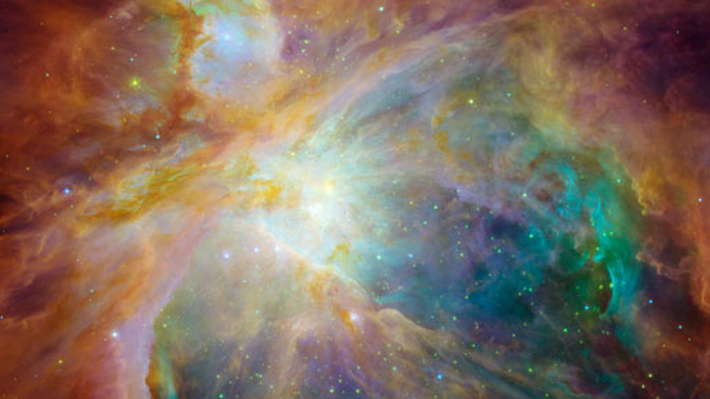
Gas and other interstellar matter within the Orion Nebula (NASA/JPL-Caltech/STScI)
Nebula
Vast clouds of interstellar dusk, hydrogen, helium and ionized gas. As the mass of a nebula grows due to the slight gravitational attracts of dust towards each other, the mass compacts enough to form stars. Other material within the nebula, such as dust, can clump together to form planets and other planetary objects. Originally, any large astronomical object was referred to as a nebula - other galaxies, in particular.
Nematic liquid crystal
A liquid crystal is a phase of matter which exhibits properties somewhere between those exhibited by a liquid and solid crystal. When viewed in high resolution, they can appear to be textured, as the molecules may be free to flow in a limited manner around, provided that they stay within a crystal like structure. Liquid crystals are used extensively in televisions and computer screens.
The nematic phase of a liquid crystal is temperature dependent. When in this phase, clamitic (rod-like) molecules align themselves individually roughly parallel to each other on their long-side axis, in a similar way to cigarettes in a package. The result of this is that the molecules are free-flowing within this directional order. In this phase, the crystals can show signs of intercommuting and loop production, which are properties expected to be exhibited by cosmic strings.

An artists impression of a neutron star (NASA/Dana Berry)
Neutron star
A neutron star is formed from the collapse of a larger star which has undergone supernova. These stars, as the name suggests, are composed mostly of neutrons. Neutron stars are extremely hot. They typically have masses between about 1 and 2 solar masses (1 solar mass is approximately 2x1030Kg, which is about 333,000 times the mass of the Earth), despite being somewhere on the order of 1015 smaller in radius than the Sun, which makes them extremely dense. The more compact a neutron star is, the more likely it is to form a black hole. This occurs when the star's density become so great that the gravitational force it exerts on itself is greater than its internal pressure, causing a collapse into a black hole.
No-boundary proposal
This was developed in 1983 by Stephen Hawking and James Hartle. Describes a situation whereby the Universe can spontaneously come into existence from literally nothing. Once the Universe exists, quantum cosmology can be approximated by general relativity so that time appears.
Nucleon
A particle is a nucleon if it is a particle that forms an atomic nucleus. There are two nucleons: protons and neutrons.
Orbifold
These are complicated manifolds which, like Calabi-Yau Manifolds, may be the space in which six extra dimensions proposed by certain string theories are found within.
Particle cosmology
The study of the Universe up to around 10-11 seconds after the Big Bang. During this time, the electroweak and strong forces were unified in a grand unified phase, which quickly changed to separate out strong and the electroweak forces. Further on in time the electroweak interaction separated to become electromagnetism and the weak nuclear force. It is possible to reach temperature regimes within this cosmology, allowing us to experimentally test theories. Speculation, however, is still required within this time period.
Path integral
A mathematical approach to non-gravitational quantum theory, introduced by Richard Feynman of Caltech. In the path integral approach, the probability that a system in an initial state A will evolve to a final state B is given by adding up a contribution from every possible history of the system that starts in A and ends in B. For this reason a path integral is often referred to as a 'sum over histories'. For large systems, contributions from similar histories cancel each other in the sum and only one history is important. This history is the history that classical physics would predict. For example, a system in the starting position of a ball on a non-symmetrical hill. The probability that the system will end up in the final position of the ball at the bottom of the hill on the side that is steepest is given by the summation of the probabilities of all paths that that ball could take, including going down the other side of the hill.
For mathematical reasons, path integrals are formulated in a background with four spatial dimensions rather than three spatial dimensions and one time dimension. There is a procedure known as 'analytic continuation' which is used to convert results expressed in terms of four spatial dimensions into results expressed in terms of three spatial dimensions and one time dimension. This effectively converts one of the spatial dimensions into the time dimension. This spatial dimension is sometimes referred to as 'imaginary' time because it involves the use of so-called imaginary numbers.
The path integral formulation of quantum gravity has many mathematical problems. It is also not clear how it relates to more modern attempts at constructing a theory of quantum gravity such as string/M-theory. However it can be used to correctly calculate quantities that can be calculated independently in other ways e.g. black hole temperatures and entropies.

Frozen Argon, melting into liquid Argon whilst also evapourating into gaseous Argon. Argon melts at 83.8 degrees Kelvin and boils at 87.3 Kelvin (Wikimedia commons)
Phase transition
A phase transition is the change in properties and form of matter due to temperature changes. For example, water changes from solid ice to liquid water to gaseous steam or vapour. As temperature drops and phase transitions occur, the symmetry of the resulting matter is reduced - again, vapour is more symmetric than water, which is more symmetric than ice. In terms of cosmology, when a phase transition in the early Universe occurs, topological defects are formed. Some of the symmetries that were broken in the early Universe led to the four fundamental forces becoming discrete forces. At higher temperatures, they reunite in a unified state.
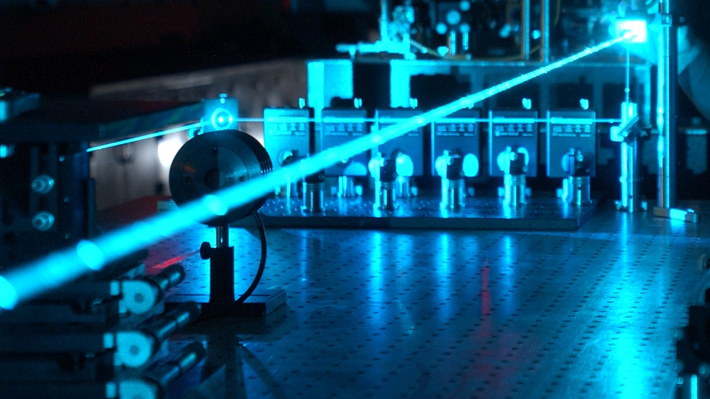
Photons focussed into a laser beam
Photon
The photon is an elementary particle. It is a gauge boson, in that it mediates one of the fundamental forces. In the case of the photon, it is the electromagnetic force. As mediators of the electromagnetic force, they allow us to see things through the visible light part of the electromagnetic spectrum, and are therefore often interchanged with "light". As they have no rest mass, they are able to travel at the fastest possible speed, which is know as the "speed of light" (299,792,458 metres per second) in a perfect vacuum. Their spin is 1 and no electrical charge.
Planck area
This is simply the Planck length squared. Given that the Planck length is a fundamental unit of length, so too is the Planck area a fundamental unit of area.
Planck constant, h
This is the size of energy quanta (discrete packets of energy) in quantum mechanics - it is therefore the smallest amount of energy that anything can hold. It is the proportionality constant between the energy of a photon and the frequency of the associated electromagnetic wave, as denoted in the Planck-Einstein equation which links the two: E=hv, where v is frequency, h is Planck's constant and E is energy. It's value is 6.6260695729×10−34 J.s
Planck Epoch
This is the earliest period of time, from the beginning of time to 10-43 seconds after the beginning of time. During this period, the fundamental forces of nature were all unified due to the unimaginable temperature of the Universe, and it is believed that gravity was as strong as the other forces (it is now by far the weakest of the forces).
Planck length
A very, very small unit of length. Its precise value is 1.61619997x10-35m. It is a base unit within the Planck unit system and it is calculated using the speed of light, c, Planck's constant, h and the gravitational constant, G. Specifically, it is given by the square root of ħG/c3 where ħ is the reduced Planck's constant, or Planck's constant divided by 2π. It is the shortest measureable length in existence. To discuss length on scale shorter than this would be meaningless because it is a physical impossibility to measure below this length. A theory that could describe physical laws at this level would be of great use in the search for a theory of everything.
Potential energy
This is the energy that exists in a body due to its position within a system. Forces act upon the body to restore it to a lower energy state or configuration, this difference in the energy states is the potential energy. When the force acts upon the body, the energy held within the body is converted into some other form of energy, this occurs because the conservation of energy law states that energy cannot be created or destroyed.
An example of potential energy being converted into other energy would be in someone skydiving. The position of the person (the body in the system) in the system (the Earth), i.e. being high up in the air in a plane, gives the person gravitational potential energy. Once they leap from the plane, this gravitational potential is turned into kinetic energy as the person falls toward Earth. Once they have landed, their position, at the surface of the Earth, means that they have lower amounts of gravitational potential energy, and they have been restored to a lower energy state.
Quantum chromodynamics (QCD)
This is the theory that explains the Strong Nuclear force that is mediated by gluons between different quarks. The charge of this force is known as colour. The force, which occurs due to an exchange of these gluons, does not weaken over distance, as say gravity does, but rather remains constant, on the order of several thousand Newtons. This means that at no point does any quark separate from another one, and so quarks can only be observed on a hadron level. This property is called confinement. Another property within QCD is asymptotic freedom. This results in a very weak interaction between quarks and gluons during extremely high energy reactions.
Quantum cosmology
This is the study of cosmology at temperature regimes where all four fundamental forces were unified. This unification, it is theorised, occurred from the Big Bang to some 10-43 seconds after the Big Bang. Due to the temperatures involved all quantum cosmology is theoretical and highly speculative.
Quantum field theory
Quantum field theory is a framework that allows for the extension of quantum mechanics, which deals with individual particles, to field systems operating relativistically. Quantum field theories have been used to describe how three of the four fundamental forces act, being mediated by and exchange of particles called bosons. The photon and the gluon, for example, are exchanged between electrons and quarks in the case of electromagnetism and the strong nuclear force respectively.
With quantum field theory, these natural fields pervade an area of space. Particles that mediate these fields, the gauge bosons associated with the field (like the aforementioned photon with electromagnetism), are quanta of these fields, that is, ripples in the field carrying small amounts of energy, other particles that act within the field, for example the electron within the electromagnetic field, are though of in a similar manner., albeit different ripples and excitations. These fields are of variable range. The colour field within the quantum chromodynamic field theory, for example, acts in a range between quarks within a nucleon. Other fields, such as the electromagnetic field, are infinite in scope and range.
Quantum gravity
The search for a theory of quantum gravity is the search for a theory that can explain the effects of the fundamental force of gravity as explained by general relativity at a quantum level, and marry these up with quantum mechanics, which is a series of models which explain the other fundamental forces; the strong nuclear; weak nuclear and electromagnetic forces. Examples of quantum gravity include string theory, loop quantum gravity and M-theory.
Quark-hadron transition
This phase transmission occurred approximately one millionth of a second after the Big Bang. This was when quark-gluon plasma underwent a phase transition, resulting in quarks forming into hadronic matter, i.e. nucleons.
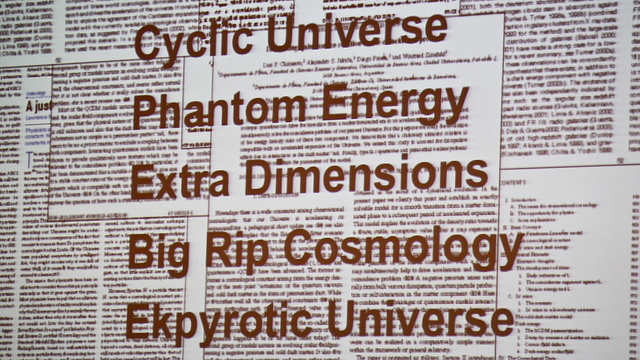
Since the discovery of the accelerating expansion of the Universe there has been published, on average, one paper published per day trying to explain it (Sir Cam)
Quintessence
Quintessence is a theory of dark energy, given to explain the acceleration of the Universe’s expansion. It is a dynamic equation, resulting in an attractive or repulsive force depending on the amount of kinetic energy relative to potential energy in the Universe. As a repulsive force, it overcomes gravity’s attraction over large scales, resulting in an accelerated expansion. Quintessence is hypothesised to have become repulsive approximately 10 billion years ago.
Radiation era
This refers to a period of time from just after Big Bang to approximately 300,000 years after its beginning. During this time, the Universe consisted of free moving protons, neutrons and electrons and other particles. All radiation was absorbed by these free electrons, making the Universe opaque. Protons and neutrons were combining to form deuterium, a heavy isotope of hydrogen, and then helium, however, the temperature of the Universe was so high that these existed as free ions in the plasma that was the Universe. It was only when the Universe was sufficiently expanded that the electrons no longer absorbed the radiation and instead joined with the ions to form neutral atoms. This forms the beginning of the matter era, in which we still exist.
Recombination
Recombination was a time period, approximately 300,000 years after the Big Bang, when electrons and protons bound to form atoms of hydrogen. Before 300,000 years had passed, the Universe was still too hot for atoms for hydrogen to form. Only after the Universe had expanded sufficiently did the Universe cool down sufficiently, making the formation of hydrogen possible.
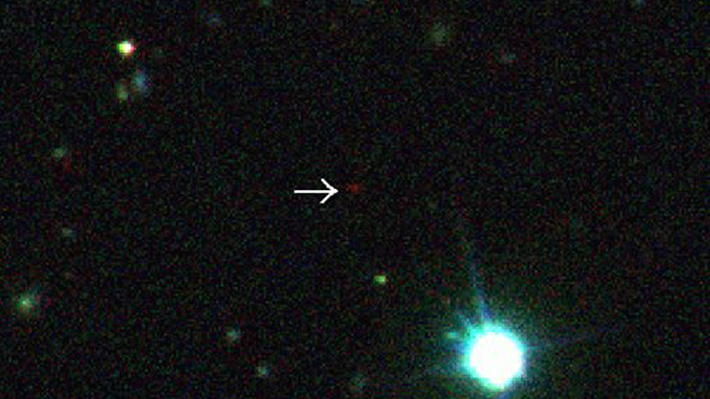
This is an example of redshift. The highlighted galaxy is the oldest object in the picture, and as it is furthest away, its radiation has moved towards the red end of the electromagnetic spectrum (Donald Schneider and Xiaohui Fan, SDSS Collaboration)
Redshift
When the source of a wave moves away from us, we observe a change of frequency of that wave. An example would be an ambulance or fire-truck - we hear a lower pitch in its siren once it has passed us by. This is the Doppler Effect. It is not, however, limited to sound waves, but any kind of waves, including electromagnetic.
This means that as an electromagnetic wave source is moving away from us, the frequency of the wave will decrease. As frequency and wavelength are inversely related, one goes up and the other goes down, the wavelength will increase. This shifts the wavelength closer to the red end of the spectrum (this, when talking about the visible part of the electromagnetic spectrum, of course the wavelength may not be in the visible part).
This is redshift, and it is something we detect from far away galaxies and other electromagnetic sources. This leads us to the conclusion that the Universe is expanding.
Scalar fields
These associate a scalar (either a number, or a physical quantity) value to every point in a space within the field. Examples of scalar fields include pressure distribution, temperature variation, and gravitational fields.
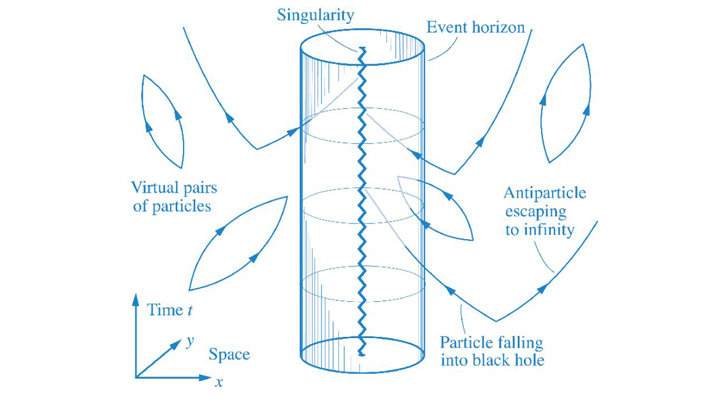
The gravitational field of a black hole will create and emit particles to infinity
Singularity
This is a point in spacetime where the curvature of spacetime becomes infinite. It is an area of extremely high density into which matter or light is attracted. Singularities can be found both at the centre of black holes and on their own. Inside a singularity, the laws of physics are distorted to the point that they are no longer applicable.
Spacetime
Spacetime is the concept of space and time being part of the same continuum. We use the typical three dimensions that are everyday and commonplace - the x, y and z dimensions used in geometry - ascribing a fourth dimension of time. This allows us to map out any event that takes place in the Universe by a set of coordinates; three of space to give us the location, and one of time to give us when the event occurred. This merging of time and space is important and must be accounted for, because relativity tells us that the observed rate of time passing changes with the respect to an objects velocity relative to the observer. Gravitational fields can also change the passage of time. On quantum scales, therefore, it is important to account for time within theoretical frameworks, whereas in classical physics this is unnecessary. The structure of spacetime is detailed in Einstein's theory of special relativity.
Special relativity
This theory lays out the structure of spacetime. It draws on the principle of relativity as laid out by Galileo, which states that there is no absolute state of rest, and that all motion is relative to other motion. There are two principles that are laid out in the theory; that the laws of physics are the same for observers whose motion is uniform relative to each other and that the speed of light in a vacuum is the same for all observers, regardless of any relative motion. This means that with different relative velocities, observers will experience different physical laws. Effects of these principles can be seen in various manners. One of the most interesting is time dilation. A clock that is sitting stationary in front of you will tick faster than a clock which is moving away from you. This is has been shown to be true for astronauts, who come back from space younger than they would have been had they remained on Earth. Another well known consequence of the theory is the energy-mass equivalence relationship, as defined by the equation E=mc2, probably the most famous equation of all time. This states that energy and mass are interchangeable and are related by a function of the speed of light in a vacuum, c. The speed of light in a vacuum, c, is shown not to be just a speed that photons travel at, it is a key cosmological constant that is related to the nature of space and time. Special relativity shows us that any object with rest mass cannot travel at the speed of light.
Speed of light, c
The speed that photons, or indeed any particle with zero rest mass (as energy and mass are equivalent as shown by the equation E=mc2, a particle that is travelling will have kinetic energy and therefore more mass than a particle at rest), will travel at in a vacuum. Its value is 299,792,458 metres per second (ms-1). As explained in the theory of special relativity, the speed of light is the fastest that any form of energy or information can travel in the Universe.
Spin
An intrinsic quantum property of particles that is defined by a spin number that can be either a whole integer (1,2,3 etc.) or a half integer (1/2,3/2,5/2 etc.), and can be positive or negative. It is a property that all particles exhibit, the sole known exception being the Higgs boson, although other particles with zero spin, such as the inflaton, have been hypothesised. To an extent, it is easy to make an analogy of quantum spin with the classic rotational spin that we encounter in everyday life, for example with a spinning top.
Particles that are electrically charged, such as electrons or positrons, will generate a magnetic field through their spin, as movement of an electric charge will automatically generate magnetic fields. This analogy, however, only takes us so far.
Different spin quantum numbers can give us ideas as to the symmetry of these particles. A particle with zero spin looks exactly the same from all sides. A particle with spin will look different if rotated, but will regain its symmetry if it is rotated a certain number of time. In this instance, an analogy of a deck of cards is useful. Consider any face card, these are symmetrical every time you spin them half way around, or 180 degrees. Consider now the Ace of Spaces. This card, if places with the point of the space facing up as you look at it, will require a full 360 degree rotation until it looks the same again. A particle with spin 1 will act like an Ace of Spaces, requiring a full rotation, whereas a spin 2 particle will be symmetrical through 180 degree rotations. A half spin particle will require two rotations to be symmetrical. This kind of rotational symmetry does not have an analogue in the macroscopic world.
Crucially, whether a particle has half or whole integer spin tells us about how it reacts. Particles with half integer spin, or Fermions, obey a set of statistics known as Fermi-Dirac statistics. Particles with whole integer spin, or Bosons, obey a set called Bose-Einstein statistics. One of the key differences between these two sets of statistics is that those particles which obey Fermi-Dirac statistics are subject to the Pauli exclusion principle. This states that particles may not occupy the same quantum state as each other. Crucially, this means that you cannot make Fermions of the same quantum state occupy the same space. This is why Fermions are the particles which make up the matter of the Universe. They include quarks, which combine to make protons and neutrons, and leptons, a set of particles that include electrons. Bosons, which do not obey Fermi-Dirac statistics and are consequently not subject to the Pauli exclusion principle, fulfill other roles, some mediate the fundamental forces of nature, these are the gauge bosons, and the Higgs boson gives rise to mass in other particles.
Standard cosmology
Also known as the ΛCDM or Lambda-CDM model, this is the best and most widely used model to explain the expansion of the Universe, origins of the cosmic microwave background, nucleosynthesis of light elements and the formation of galaxies and large-scale structure.
Statistical mechanics
This is a set of mathematical tools that allow us to study thermodynamical properties, such as work, heat and entropy, of a large number of particles, allowing us to look at both atomic level and macroscopic level detail of the system. This allows us to explain thermodynamics in ways that apply to both classical and quantum physics, and allows us to extrapolate macroscopic predictions from microscopic properties.
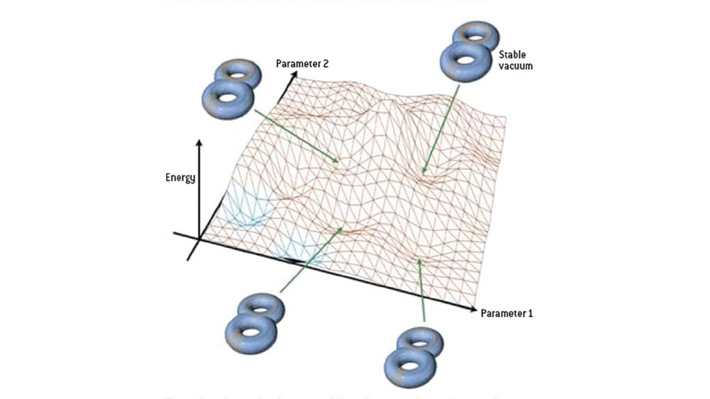
The string theory landscape: stable universes exist as the troughs in this energy diagram, but there are many possibilities for our Universe
String Theory
In the standard model of particle physics, particles are considered to be points moving through space, tracing out a line called the World Line. To take into account the different interactions observed in nature, one has to provide particles with more degrees of freedom than only their position and velocity. These include mass, electric charge, colour (which is the “charge” associated with the strong interaction) and spin. This model was designed within a framework known as Quantum Field Theory (QFT), which allows us to build theories consistent with both quantum mechanics and the special theory of relativity. These theories describe with great success three of the four known interactions in nature: electromagnetism, the strong and weak nuclear forces. Unfortunately, gravity, as described by Einstein’s General Relativity, does not fit into this scheme.
String Theory replaces these different particle types with a single fundamental building block: a “string”. These can be closed, like loops, or open, like a hair. As the string moves through time it traces out a tube or a sheet (depending on whether it is closed or open). This String is free to vibrate, and different vibrational modes of the string represent the different particle types, as difference modes are seen as different masses or spins.
One mode of vibration, or ‘note’, makes the string appear as an electron, another as a photon. There is even a mode describing the graviton, the particle carrying the force of gravity. This means we can make sense of the interaction of gravitons in a way we could not in QFT. It is this ability of String Theory to create a valid model that includes all four fundamental interactions that has dubbed it to be a ‘Theory of Everything’.
The problem is that there are five different versions of String Theory. This is why we now look to M-Theory, which has place for all five theories, as the greatest solution to our ‘Theory of Everything’. As a point of note, string theory predicts that spacetime has ten dimensions. Although we only have three dimensions of space and one of time, we can assume that six of these dimensions are curled up very tightly, so that we may never be aware of their existence. Having these so-called compact dimensions is very beneficial, as we can suggest that the degrees of freedom, such as electric charge of an electron, can simply arise as motion in the extra compact dimensions.
Strong and Electroweak forces
There are four fundamental forces in nature. They are Electromagnetism, the Weak Nuclear Force, the Strong Nuclear Force and Gravitation. The Weak Nuclear Force is associated with radioactivity in unstable nuclei, specifically the decay of a neutron into a proton. When the temperature is hot enough, such as that of the Universe shortly after the Big Bang, Electromagnetism and the Weak Nuclear Force will merge to form the Electroweak Force.
The Strong Nuclear Force binds together neutrons and protons inside nuclei. The mathematical theory describing the elementary particles in this theory, Quarks and Gluons, is known as Quantum Chromodynamics (QCD).
Theories that unify the strong nuclear force with Electroweak Theory are known as Grand Unified Theories, of GUTs.
Supercluster
A supercluster is a vast (the are some of the largest structures in the Universe) grouping of smaller galaxy clusters and groups. They can span between several hundred million light years to over one billion light years. Superclusters can contain galaxy bubbles, sheets, voids and filaments, which are smaller structures within the supercluster. Nearly all galaxies are found within superclusters, and inbetween superclusters thee are usually large voids. Our own supercluster, called the Virgo Supercluster, contains the Local Group, the Virgo cluster and some 100 other galactic groups and clusters. Its diameter is approximately 100 million light years.
Supergravity
Supergravity is a theory which follows on from supersymmetry. It is theorised that in the same way that photons mediate the electromagnetism, gluons the strong nuclear force and W and Z bosons the weak nuclear force, so to does the as-yet undiscovered graviton the gravitational force. In supergravity, the graviton has a heavier superpartner whose spin differs by 1/2. So far, as with supersymmetry, there has been no observational evidence for supergravity.
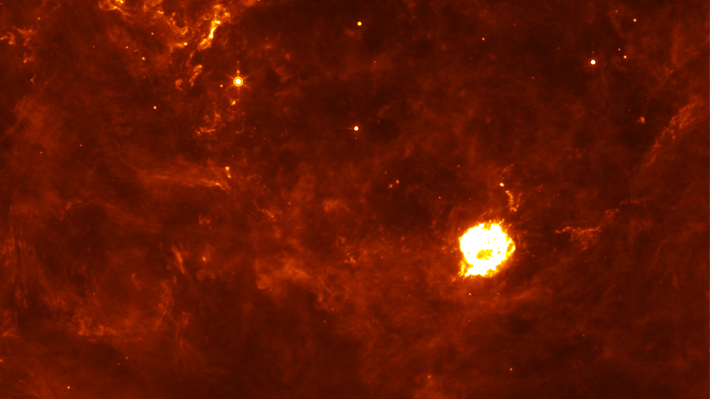
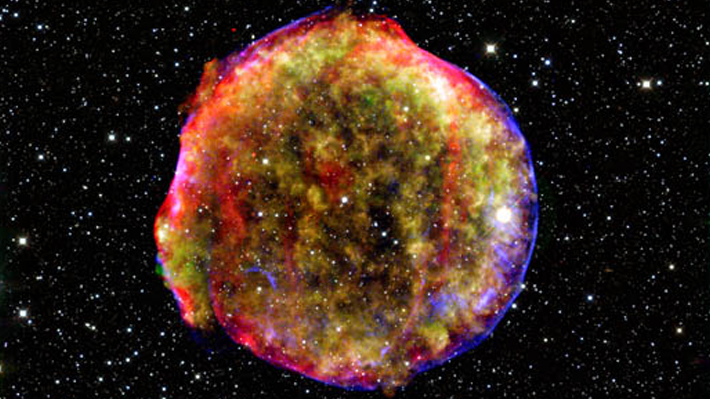
Figure 1. (left): Cassiopeia A beginning to supernova (NASA/JPL-Caltech/E. Dwek and R. Arendt)
Figure 2. (right): Composite image of the Tycho supernova remnant. This supernova was seen by Danish astronomer Tycho Brahe four centuries ago (MPIA/NASA/Calar Alto Observatory)
Supernova
This is a very powerful stellar explosion that can quite often outshine galaxies. A star undergoes a supernova either when a very old massive star undergoes sudden gravitational collapse, releasing vast quantities of gravitational energy, or through the reignition of the nuclear fusion reaction in a degenerate star's (such as a white dwarf or neutron star) core. The explosion releases huge quantities of the star's matter, resulting in a supernova remnant. Certain types of supernova have luminosities of known quantity, such that they can be used as 'standard candles', which means that we can detect how far away the object is by comparing its known luminosity with our observed brightness.
Superstring Theory
String Theory states that all particles are representations of different vibrations on a fundamental building block; a string. As a theory, it is able to describe the interactions of the particle that mediates gravitation: the graviton. In this way, and by being able to describe all other particles and interactions thereof, it is able to unite the four fundamental forces in nature, and is therefore a ‘Theory of Everything’.
The original String Theory only described particles with integer spins, called bosons. These are the particles that mediate the fundamental forces, and include the photon, electron, gluon and graviton. The other class of particle, which have half integer spin, called fermions, were not described. These are particles that constitute matter as we know it, such as quarks and electrons.
By introducing supersymmetry to bosonic string theory, we obtain a new theory that describes both the forces and the matter that make up the Universe. This is Superstring Theory. There are three different Superstring Theories that have no mathematical inconsistencies. In two of them, the fundamental object is a closed string, whilst in the third, the string is open.
By mixing the best aspects of bosonic String Theory and Superstring Theory, we can create two other consistent theories of strings, Heterotic String Theories
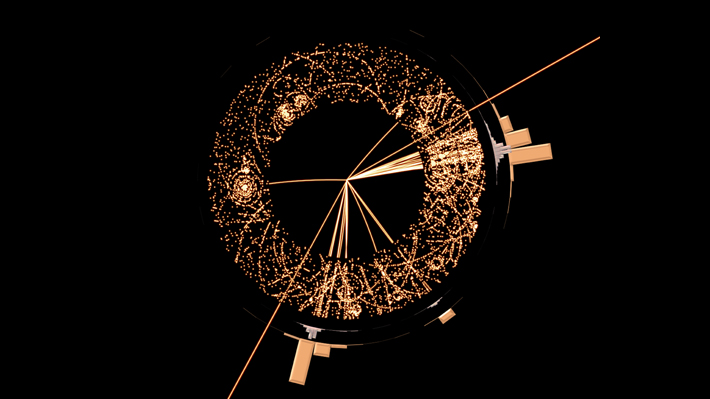
The readings of a hypothetical "supersymmetry event" - a particle collision of such energy that supersymmetric particles are created - at ATLAS, one of the experiments within the Large Hadron Collider at CERN (ATLAS Experiment © 2012 CERN)
Supersymmetry
Supersymmetry is a theory which postulates that for every elementary particle, there is a more massive "superpartner" whose spin is different by 1/2. The theory comes about to solve mathematical difficulties related to quantum field theory and the reconciling of general relativity and quantum field theory. These inconsistencies arise because the Higgs boson, a gauge boson whose interaction with other particles gives them mass, appears to gain large amounts of mass through interactions with itself. Solving these inconsistencies would give physicists a way to marry quantum mechanics and gravity at the smallest scales.
These superpartners are a possible candidate for dark matter. No superpartners have yet to be detected and no evidence exists as of yet to support supersymmetry. This is because in order to observe particles of this mass we need to use incredible amounts of energy, which so far we have been unable to generate. It is hoped that the Large Hadron Collider at CERN might detect evidence of supersymmetric particles.
Surface of last scattering
This is the set of points in space where decoupling occurred, approximately 380,000 years after the Big Bang, at the right distance so that we are now seeing these photons reach us as part of the Cosmic Microwave Background relic radiation.
Symmetry breaking
This occurs when a system in some state of symmetry moves into a different configuration, resulting in the loss of that symmetry. Consider a ball on a hill. The ball is symmetrical. The hills is also symmetrical. If the ball is on top of the hill, the ball and hill in system are symmetrical. If the ball rolls down the hill, the ball and hill are individually still symmetrical, but the system of the ball and the hill is now asymmetrical. This is symmetry breaking.
In a cosmological context, this happened as the Universe cooled down after the Big Bang. As this occurred, elementary particles changed state in what is known as a phase transition. As this occurred, symmetry that previously was exhibited by these particles was broken. These symmetries are associated with different fundamental forces. This is why some particles are acted upon by these forces, and others not. These symmetries are restored at higher temperatures, however.
Textures
These are a type of topological defect that is hypothesised to form when large symmetries are broken. They are unstable and prone to collapse. Unlike certain other topological defects, such as magnetic monopoles, these are delocalized and occur over large areas. No evidence has been found of them as yet.
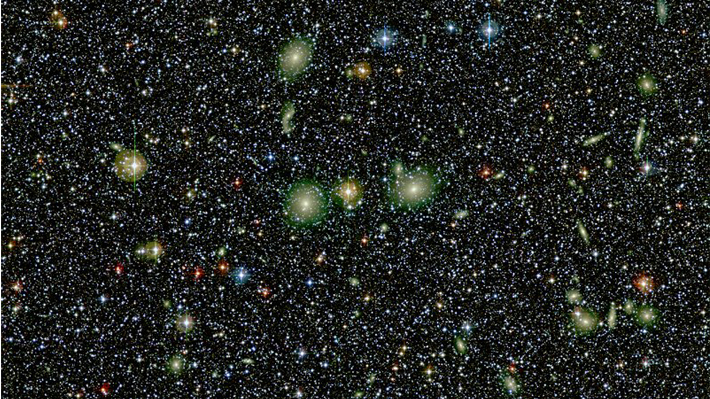
Galaxies in Norma Cluster moving toward the centre of The Great Attractor. The nature of this gravitational anomaly is unknown (2P2 Team/WFI/MPG/ESO)
The Great Attractor
This is a gravitational anomaly located in the Centaurus Supercluster. It is a localized concentration of mass of unknown origin that is equivalent to tens of thousands of galaxies. It mass is so large, that (as the name suggests) its gravitational attraction is altering the motion of galaxies and galaxy clusters in a region over hundreds of millions of light years across.
Theory of Everything
In the aftermath of the Big Bang, the Universe was extremely hot and extremely dense. At these energies, the laws of nature that we know were changed. The fundamental forces that we see in nature were unified - it is only as the Universe expanded and cooled that Gravitation, Electromagnetism and the Strong and Weak nuclear forces all ceased to be as one. Electroweak theory describes the unification of the Weak Nuclear force and Electromagnetism. A Theory of Everything will marry up all the fundamental forces.
The issue with this is that whilst quantum chronodynamics and the electroweak theory describe the Strong and Weak nuclear forces and electromagnetism on a well understood quantum basis, there is no consistent theory for describing gravity on such a basis. M-Theory, and the associated String Theories behind it are being explored as possible candidates.
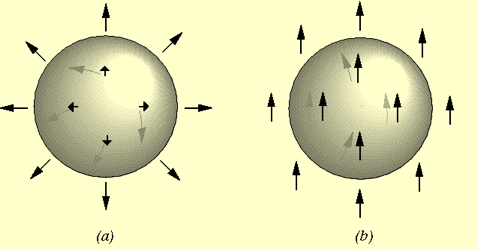
Topological defects include magnetic monopoles, which are represented by diagram A here
Topological defects
These are configurations of matter that form during matter phase transitions and symmetry breakings, such as occurred during the very early Universe. They are configurations of matter in the old, symmetrical phase that remain stable in the new phase where the symmetry that was previously held is now broken. Examples of these defects include monopoles, cosmic strings, domain walls and textures.
Vacuum manifold
Within quantum field theory, particles may move from higher to lower energy states, such as occurred in the very early Universe as the Universe was expanding and thus cooling. These lower energy states, or vacuum states, may be different whilst possessing the same amount of energy. This means these states are degenerate. The particle, therefore, has a chance of falling into any of these degenerate vacuum states, unless there is something outside the system described here which will cause one state to be preferred over the other. This set of vacuum states is called the vacuum manifold.
World Line
The world line of an object is the path it traces out as it travels through spacetime. It different from trajectory or orbit due to the inclusion of time as a dimension in addition to the three dimensions of space.
Yang-Mills Theory
A Yang-Mills theory is any quantum theory that is symmetric under a non-abelian gauge group. A gauge group is abelian depending upon whether the gauge transformations are commutative, that is, it does not matter in which order you apply the transformations, you will have the same results (a simply analogy is 1x22, it does not matter in which order you perform the operations, the result will always be 4). An example of this kind of theory would be Quantum Chromodynamics, which deals with the strong nuclear force.

